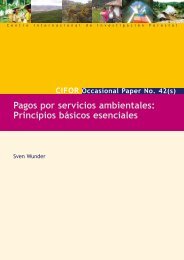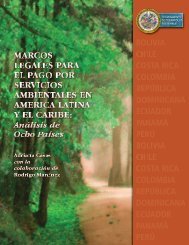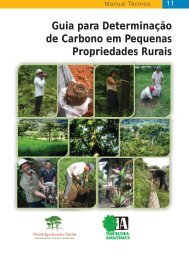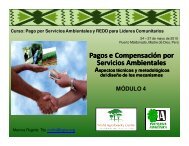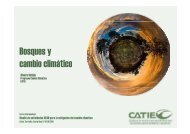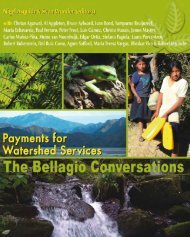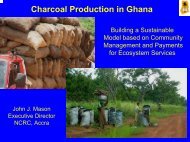Guide on Climate Change and Indigenous Peoples
Guide on Climate Change and Indigenous Peoples
Guide on Climate Change and Indigenous Peoples
- No tags were found...
You also want an ePaper? Increase the reach of your titles
YUMPU automatically turns print PDFs into web optimized ePapers that Google loves.
2Why is Biodiversityimportant?The variety of plants, animals <strong>and</strong> micro-organisms supports arange of services provided by healthy ecosystems to humans:Ecosystem Services/Functi<strong>on</strong>sSupporting servicesRegulating servicesProvisi<strong>on</strong>ing servicesCultural servicesMaintain c<strong>on</strong>diti<strong>on</strong>s for life <strong>on</strong> earth: Soil formati<strong>on</strong> <strong>and</strong>retenti<strong>on</strong>, nutrient cycling, primary producti<strong>on</strong>Regulati<strong>on</strong> of air quality, climate, floods, soil erosi<strong>on</strong>,water purificati<strong>on</strong>, waste treatment, pollinati<strong>on</strong>, biologicalc<strong>on</strong>trol of human, livestock, <strong>and</strong> agriculture pests <strong>and</strong>diseasesProviding food, fuelwood, fiber, biochemicals, naturalmedicines, pharmaceuticals, genetic resources, freshwaterN<strong>on</strong> material benefits including cultural diversity <strong>and</strong>identity, spiritual <strong>and</strong> religious values, knowledgesystems, educati<strong>on</strong>al values, inspirati<strong>on</strong>, aestheticvalues, social relati<strong>on</strong>s, sense of place, cultural heritage,recreati<strong>on</strong>, communal <strong>and</strong> symbolic valueshttp://www.f<strong>on</strong>tplay.com/freephotos/Importance of Biodiversity for the First<strong>Peoples</strong> of British Columbia (Turner, 2007)• Food: Traditi<strong>on</strong>al diets - plants <strong>and</strong> animals found in the wild <strong>and</strong> somefungi such as mushrooms have sustained <strong>and</strong> nourished people for manygenerati<strong>on</strong>s.• Material resources/Technology: plant <strong>and</strong> animal materials used as orc<strong>on</strong>structed as tools <strong>and</strong> equipment for livelihood, shelter, <strong>and</strong> clothing.• Medicine: Plants, <strong>and</strong> some animals <strong>and</strong> fungi, provide people withmedicines for maintaining health <strong>and</strong> treating injuries <strong>and</strong> ailments.• Comp<strong>on</strong>ents of Culture: Plants, animals <strong>and</strong> fungi are prominent in FirstNati<strong>on</strong>s’ belief systems, art, s<strong>on</strong>gs <strong>and</strong> cerem<strong>on</strong>ies. Their world renownedart forms representing stylized animals reflect intense c<strong>on</strong>necti<strong>on</strong>s with<strong>and</strong> reliance <strong>on</strong> biodiversity.• Ecological Indicators: The flowering of certain plants, the s<strong>on</strong>gs ofcertain birds, or the appearance of certain types of butterflies or otherinsects, are signs of seas<strong>on</strong>al change or of the time for some importantharvest event.100 <str<strong>on</strong>g>Guide</str<strong>on</strong>g> <strong>on</strong> <strong>Climate</strong> <strong>Change</strong> <strong>and</strong> <strong>Indigenous</strong> <strong>Peoples</strong>



